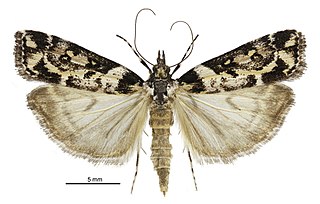
Delias descombesi, the redspot Jezebel is a medium-sized butterfly of the family Pieridae, that is, the yellows and whites.

Arhopala abseus, the aberrant oakblue or aberrant bushblue, is a species of lycaenid or blue butterfly found in Asia.
Trichoptilus scythrodes is a moth of the family Pterophoridae that can be found in Australia, including New South Wales and South Australia.

Micropardalis doroxena is a species of moth belonging to the family Micropterigidae. It was described by Edward Meyrick in 1888. It is endemic to the North Island of New Zealand.

Lichenaula lichenea is a species of moth of the family Xyloryctidae. It is known in Australia from the Australian Capital Territory, New South Wales and Queensland.

Lichenaula calligrapha is a species of moth of the family Xyloryctidae. It is known from rainforests from northern Queensland to Victoria, although it has also been recorded from the Australian Capital Territory, New South Wales and Tasmania.

Eudonia diphtheralis is a species of moth in the family Crambidae. It is endemic to New Zealand.

Izatha apodoxa is a moth of the family Oecophoridae. It is endemic to New Zealand, where it is known from scattered localities in the southern North Island. This species is variable in appearance and comes in two forms, a grey form and a black and white form. In the grey form it is very similar in appearance to I. notodoxa and in the black and white form to I. katadiktya. At present the larvae and biology of this species is unknown.
Heterocrossa gonosemana is a species of moth in the family Carposinidae. It is endemic to New Zealand.
Microphysetica ambialis is a moth in the family Crambidae. It was described by William Schaus in 1924. It is found in Mexico (Xalapa) and Guatemala.
Piletocera agathanalis is a moth in the family Crambidae. It was described by William Schaus in 1924. It is found in Panama.
Prodelaca myodes is a moth in the family Oecophoridae. It was described by Edward Meyrick in 1883. It is found in Australia, where it has been recorded from Queensland and New South Wales.
Garrha sericata is a moth in the family Oecophoridae. It was described by Edward Meyrick in 1883. It is found in Australia, where it has been recorded from Queensland and New South Wales.
Gonioterma exquisita is a moth in the family Depressariidae. It was described by W. Donald Duckworth in 1964. It is found in Brazil.
Mesoscia dyari is a moth of the Megalopygidae family. It was described by Schaus in 1912. It is found in Costa Rica.
Mesoscia lorna is a moth of the Megalopygidae family. It was described by Schaus in 1905. It is found in French Guiana.
Mesoscia terminata is a moth of the Megalopygidae family. It was described by Schaus in 1905. It is found in Costa Rica and French Guiana.
Podalia albescens is a moth of the family Megalopygidae. It was described by William Schaus in 1900. It is found in Brazil.
Podalia amarga is a moth of the family Megalopygidae. It was described by Schaus in 1905.
Podalia thanatos is a moth of the Megalopygidae family. It was described by William Schaus in 1905. It is found in Costa Rica and Guyana.






